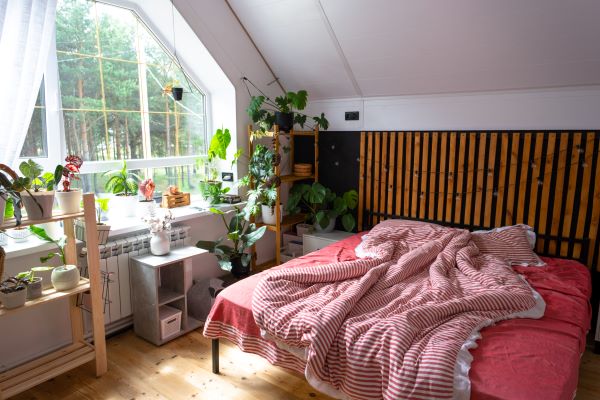Creating a healthier home environment is essential for our well-being. With the increasing amount of time spent indoors, it’s crucial to consider how our living spaces impact our health, comfort, and overall quality of life. This article delves into practical and effective tips to enhance your home’s health across various aspects, from air and water quality to reducing chemical exposure. Implementing these strategies can lead to a more enjoyable, safer, and healthier home for you and your family.
Contents
Optimize Indoor Air Quality

Indoor air quality significantly influences our health, comfort, and productivity. Poor air quality can lead to respiratory issues, allergies, and other health problems. Implementing air purifiers can play a vital role in capturing pollutants, such as dust, pollen, and volatile organic compounds (VOCs), ensuring cleaner air inside the home. Regular ventilation is another crucial practice; it helps dilute indoor pollutants by allowing fresh air from outside to circulate within the home. This can be as simple as opening windows daily or using exhaust fans in areas like kitchens and bathrooms.
Introducing indoor plants is a natural and aesthetically pleasing way to help purify the air. Certain plants, such as spider plants, snake plants, and peace lilies, have been shown to absorb toxins and improve indoor air quality. However, it’s important to balance the benefits with potential challenges, such as mold growth in the soil, by ensuring adequate light and not overwatering. Together, these strategies form a comprehensive approach to optimizing indoor air quality, contributing to a healthier and more comfortable home environment.
Reduce Chemical Exposure

Our homes are often filled with products that emit harmful chemicals, negatively affecting our health. From cleaning products to personal care items, exposure to chemicals like phthalates, parabens, and formaldehyde is a common concern. Switching to natural cleaning products can significantly reduce chemical exposure in the home. Ingredients such as vinegar, baking soda, and lemon juice offer powerful and safe alternatives for a clean home without the risk of chemical exposure.
Another key area of concern is the use of plastics, especially for food storage. Plastics can leach chemicals like BPA into food, posing health risks. Opting for glass or stainless steel containers is a safer alternative. Additionally, when redecorating or renovating, choosing low-VOC paints and furnishings can further reduce exposure to harmful chemicals. These changes not only minimize health risks but also contribute to a safer, more sustainable home environment.
Enhance Water Quality

Water is a fundamental aspect of a healthy home, yet its quality can vary significantly. Contaminants in water, such as lead, chlorine, and pesticides, can have serious health implications. Installing water filters is an effective way to enhance the quality of your drinking water. Filters can vary from pitcher filters to more advanced under-sink or whole-house systems, depending on the specific contaminants present and the volume of water used.
Regular testing of water quality is important for identifying potential issues and determining the most appropriate type of filtration. Home water testing kits are readily available and can test for a variety of contaminants. Additionally, safe water storage practices, such as using clean, non-reactive containers and avoiding the storage of water in direct sunlight, can prevent bacterial growth and chemical leaching. By taking these steps, homeowners can ensure that their water supply supports their health and well-being.
Promote A Healthy Diet

The environment of our homes plays a significant role in shaping our eating habits, which in turn affects our overall health. A well-organized kitchen that is stocked with healthy food options encourages better eating habits. Designating specific areas for fruits, vegetables, and whole grains can make healthier choices more convenient and appealing. Furthermore, the presence of kitchen equipment like blenders for smoothies or steamers for vegetables can facilitate the preparation of nutritious meals, making it easier to maintain a healthy diet.
Growing a kitchen garden, whether on a windowsill, balcony, or backyard, provides a fresh and readily available supply of herbs, vegetables, and fruits, enriching your diet with essential nutrients. This practice not only promotes healthier eating habits by incorporating more fresh produce into meals but also fosters a deeper connection with the food we consume. Proper storage of food is another critical aspect, as it helps preserve the nutritional value and freshness of food. Utilizing clear containers for healthy snacks and keeping unhealthy options out of sight can further support healthy eating habits in the home.
Encourage Physical Activity

Physical activity is crucial for maintaining health, and the design of our homes can significantly influence our ability to stay active. Creating a dedicated space for exercise within the home can make engaging in regular physical activity more convenient and appealing. This space doesn’t need to be large; even a small area equipped with a yoga mat, resistance bands, or free weights can serve as an effective home gym. Additionally, incorporating elements that bring joy and motivation, such as inspiring posters or a dedicated playlist, can enhance the exercise experience.
The concept of active design in home layout can also encourage movement throughout the day. For example, placing frequently used items in locations that require standing or walking can naturally integrate more activity into daily routines. Standing desks or active sitting options, such as balance balls, can promote better posture and increased energy expenditure during work or study. Moreover, utilizing outdoor spaces for physical activity, such as gardening or playing with pets, not only increases physical activity but also provides exposure to natural sunlight, further boosting overall health.
Ensure Restful Sleep

A good night’s sleep is foundational to health, and the sleep environment plays a critical role in determining the quality of rest we receive. The bedroom should be a sanctuary designed for optimal sleep, with considerations for lighting, temperature, and noise levels. Using blackout curtains to minimize light exposure, setting the thermostat to a cool and comfortable temperature, and utilizing white noise machines or earplugs to block out disruptive sounds can significantly improve sleep quality. Moreover, the choice of mattress and pillows should be personalized to support individual comfort and alignment, contributing to restorative sleep.
Minimizing electronic device usage before bedtime is another important factor in ensuring restful sleep. The blue light emitted by screens can disrupt the body’s natural circadian rhythms, making it harder to fall asleep. Establishing a pre-sleep routine that avoids electronic devices and includes relaxing activities, such as reading or taking a warm bath, can help signal to the body that it’s time to wind down. These practices, combined with maintaining a consistent sleep schedule, can significantly enhance the quality of sleep and, by extension, overall health and well-being.
Foster Mental Well-being

The home environment can significantly affect mental health, influencing feelings of stress, anxiety, and overall mood. Creating spaces within the home that are dedicated to relaxation and mindfulness can have a profound impact on mental well-being. For example, a quiet corner equipped with comfortable seating, soft lighting, and elements of nature, such as plants or a small fountain, can serve as a personal retreat for meditation, reading, or simply unwinding. Personalizing these spaces with items that bring joy, such as favorite books or artwork, can further enhance the sense of tranquility and escape from the stresses of daily life.
Natural light and views of the outdoors are also essential for mental health, as they help regulate circadian rhythms and can improve mood. Maximizing natural light through the strategic placement of mirrors or choosing translucent window treatments can brighten spaces and create a more uplifting environment. Additionally, decluttering living spaces can lead to a more peaceful and stress-free home environment. Regularly organizing and clearing out unnecessary items reduces visual clutter, which can help calm the mind and promote a sense of control and well-being.
Bringing It All Together for a Healthier Home
Embracing these essential tips for a healthier home environment can lead to significant improvements in your well-being and quality of life. From optimizing air and water quality to fostering mental well-being and ensuring a safe living space, each step contributes to a more wholesome and healthy lifestyle. Remember, the journey to a healthier home doesn’t require drastic changes overnight but rather thoughtful, incremental adjustments that collectively make a substantial difference. By prioritizing these aspects of home health, you can create a sanctuary that supports your physical, mental, and emotional health every day.


